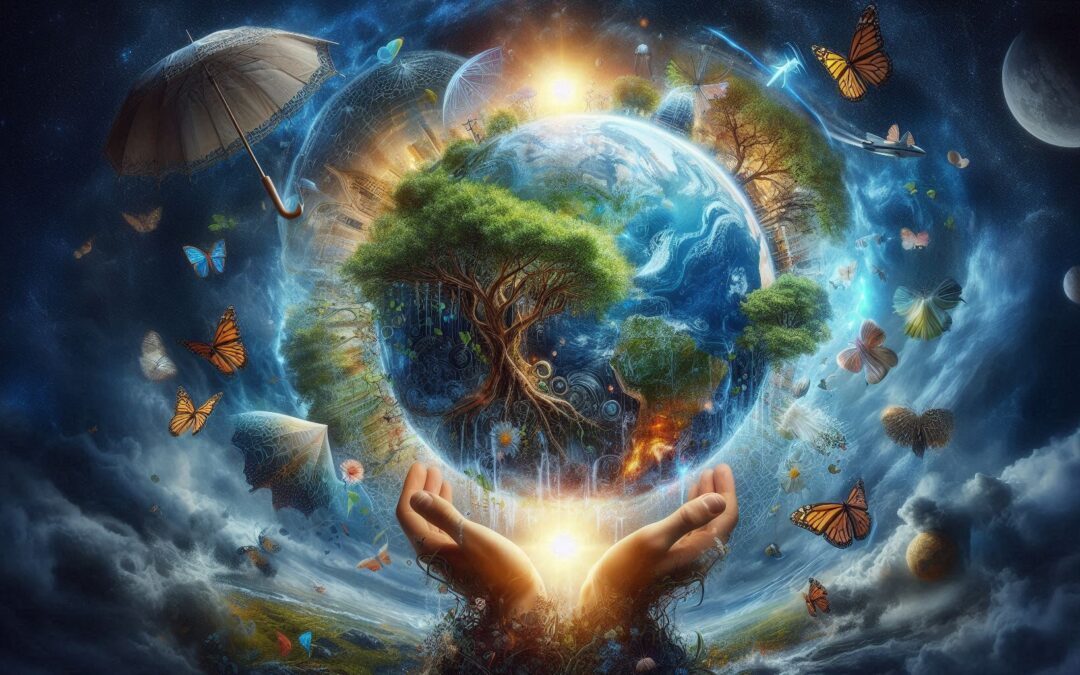“If you really think that the environment is less important than the economy, try holding your breath while you count your money.” Guy McPherson
Breathe Deeply, Drink Wisely: Why It’s Important To Protect Our Planet From Climate Change For Every Living Being
Introduction to Climate Change
“Climate change is the defining issue of our time, and we are at a defining moment.” – United Nations. This powerful statement captures the urgency and importance of climate change in our lives today. Did you know that since the late 19th century, the planet’s average surface temperature has risen about 2.12 degrees Fahrenheit (1.18 degrees Celsius), with most of the warming occurring in the last 40 years?
To understand the delicious complexity of our planet’s climate, we must first differentiate between weather and climate. Weather refers to the short-term conditions of the atmosphere in a specific place at a specific time, such as a sunny day or a rainy afternoon. Climate, on the other hand, is the average weather conditions in a region over a long period, typically 30 years or more. Climate change encompasses significant changes in temperature, precipitation, wind patterns, and other aspects of the earth’s climate system over an extended period.
Why is understanding climate change so crucial for everyone? The answer lies in the air we breathe, the water we drink, and the food we eat. Climate change is not just an environmental issue; it’s a human issue that affects our health, our communities, and our future. The rising global temperatures are causing more frequent and severe weather events, such as hurricanes, wildfires, and droughts, impacting millions of lives. Furthermore, climate change threatens biodiversity, with many species facing extinction due to habitat loss and changing ecosystems.
Our journey to understanding and addressing climate change is a beautiful and essential one. As we delve deeper into this topic, we will uncover the interconnectedness of all living beings and the delicious harmony that exists when we treat our planet with love and respect. Remember, every small action counts, and together, we can make a difference for the betterment of our earth and all its inhabitants.
Causes of Climate Change
Greenhouse Gas Emissions
At the heart of climate change lies the issue of greenhouse gas emissions. These gases, including carbon dioxide (CO2), methane (CH4), and nitrous oxide (N2O), trap heat in the atmosphere, leading to the warming of our planet. The burning of fossil fuels, such as coal, oil, and natural gas, is the primary source of these emissions. In 2020, global CO2 emissions reached a staggering 34.81 billion metric tons, with the energy sector being the largest contributor.
- Burning fossil fuels for electricity and heat production
- Transportation powered by gasoline and diesel
- Industrial processes that release greenhouse gases
Deforestation
Our planet’s forests are a delicious symphony of life, providing habitat for countless species and playing a critical role in absorbing CO2 from the atmosphere. However, deforestation is rapidly diminishing these vital carbon sinks. Each year, approximately 10 million hectares of forest are lost, contributing significantly to increased CO2 levels.
- Clearing forests for agriculture and livestock
- Logging for timber and paper products
- Urban expansion and infrastructure development
Industrialization
The marvels of industrialization have brought us many conveniences, but they have also led to an increase in greenhouse gas emissions. Factories and industrial plants emit a significant amount of CO2 and other pollutants, contributing to the air we breathe becoming less clean and more hazardous to our health. The industrial sector accounts for about 21% of global greenhouse gas emissions.
- Cement production releasing CO2
- Chemical manufacturing emitting various pollutants
- Metal production contributing to greenhouse gases
Agriculture
Agriculture is another major contributor to climate change, with activities such as livestock farming and rice cultivation producing significant amounts of methane and nitrous oxide. These gases have a much higher warming potential than CO2, making their impact especially profound.
- Livestock farming producing methane through enteric fermentation
- Rice paddies emitting methane
- Fertilizer use releasing nitrous oxide
Waste Management
How we manage our waste also plays a role in climate change. Landfills produce methane as organic waste decomposes anaerobically. Moreover, the incineration of waste releases CO2 and other harmful pollutants into the atmosphere.
- Landfills emitting methane
- Waste incineration releasing CO2
- Improper waste disposal contributing to pollution
These causes of climate change are interconnected, much like the web of life on our beautiful planet. By understanding these causes, we can take meaningful steps to reduce our impact and protect the air we breathe, the water we drink, and the food we eat. Let’s embark on this delicious journey of change together, for the health of our planet and all its inhabitants.

Effects of Climate Change
Climate change affects every corner of our beautiful planet, from the icy polar regions to the lush forests and vast oceans. Understanding these effects can inspire us to take action to protect the air we breathe, the water we drink, and the food we eat.
Comparing Effects on Different Ecosystems
| Ecosystem | Effects |
|---|---|
| Polar Regions |
|
| Forests |
|
| Oceans |
|
Case Study: The Pacific Islands
The Pacific Islands are a beautiful tapestry of culture, community, and natural splendor, but they are also on the frontlines of climate change. Rising sea levels and increased storm activity are having devastating impacts on these islands.
- Local Communities: Coastal erosion is forcing communities to relocate, disrupting lives and traditions.
- Wildlife: Marine species such as fish and corals are under threat due to warmer ocean temperatures and acidification.
“We are seeing our homes and livelihoods disappear before our eyes,” says environmental activist Moana Luafutu. “But we are resilient and will continue to fight for our islands.”
Climate Change Quotes
These powerful words from researchers and activists underscore the urgency of addressing climate change:
“The evidence of climate change is unequivocal. We must act now to protect our planet for future generations.” – Dr. Jane Goodall
“We simply must do everything we can in our power to slow down global warming before it is too late… The science is clear. The global warming debate is over.” – Arnold Schwarzenegger
“Every small action counts. Together, we can make a difference in preserving the delicious beauty of our world.” – Greta Thunberg
“The world must come together to confront climate change. There is little scientific dispute that if we do nothing, we will face more drought, famine and mass displacement that will fuel more conflict for decades.” – Barack Obama
The effects of climate change are widespread and profound, but by coming together, we can take steps to mitigate these impacts. Let’s cherish and protect this magnificent planet we call home, for the sake of every living being.
Mitigation Strategies
As we breathe deeply and drink wisely, let us also take deliberate steps to mitigate climate change. These strategies are not just policies but beautiful acts of kindness to our Earth, ensuring that every living being can thrive in harmony.
Renewable Energy
Renewable energy is like the delicious sunshine that nourishes our planet. Embracing these clean energy sources can significantly reduce carbon emissions.
- Solar Power: Installing solar panels on homes and buildings.
- Wind Energy: Supporting wind farms and policies promoting wind energy.
- Hydropower: Encouraging the use of hydroelectric power where feasible.
According to the International Energy Agency, renewable energy sources accounted for almost 30% of global electricity generation in 2020, reducing millions of tons of CO2 emissions.
Policy Changes
Policy changes are like the roots of a thriving tree, grounding our efforts to combat climate change.
- Carbon Pricing: Implementing carbon taxes or cap-and-trade systems.
- Regulations: Enforcing stricter emissions standards for industries.
- Subsidies: Providing incentives for renewable energy projects.
Countries with carbon pricing have seen a reduction in emissions by up to 12%, according to World Bank data.
Individual Actions
Individual actions are the vibrant petals of a flower, each contributing to the overall beauty and health of our environment.
- Reduce Waste: Composting organic waste and recycling materials.
- Use Public Transport: Opting for public transport, biking, or walking instead of driving.
- Support Sustainable Brands: Choosing products from companies committed to sustainability.
According to the Environmental Protection Agency, if every American replaced one incandescent light bulb with an Energy Star-rated bulb, we could save enough energy to light 3 million homes for a year.
Effectiveness of Mitigation Strategies
| Strategy | CO2 Reduction |
|---|---|
| Solar Power | By 2030, solar power could reduce annual CO2 emissions by 1.5 billion metric tons. |
| Wind Energy | Wind energy could prevent 1.8 billion metric tons of CO2 emissions annually by 2050. |
| Carbon Pricing | Carbon pricing has the potential to reduce emissions by up to 12% globally. |
Implementing these strategies will be like weaving a tapestry of hope and resilience, ensuring that the air we breathe, the water we drink, and the food we eat remain pure and plentiful for generations to come. Together, we can make our planet a delicious place to live.
Adaptation Measures
In our journey to protect the air we breathe, the water we drink, and the food we eat, adaptation measures are essential. These strategies help us adjust to the changes already set in motion by our past actions, ensuring a delicious future for every living being.
Infrastructure Changes
Infrastructure changes are like the sturdy branches of a tree, supporting and protecting us from the harsh impacts of climate change.
- Flood Defenses: Constructing levees, seawalls, and improved drainage systems to protect against rising sea levels.
- Green Buildings: Designing buildings to be energy-efficient and resilient to extreme weather conditions.
- Resilient Transportation: Developing transportation systems that can withstand climate impacts.
The Global Commission on Adaptation reports that investing in more resilient infrastructure could yield a $4 return for every $1 invested.
Agricultural Adjustments
Agricultural adjustments are like the nourishing soil that allows our communities to flourish despite changing climates.
- Drought-Resistant Crops: Developing and planting crops that can thrive in drier conditions.
- Efficient Water Use: Implementing drip irrigation and other water-saving techniques.
- Agroforestry: Integrating trees and shrubs into farming systems to enhance biodiversity and resilience.
The Food and Agriculture Organization notes that climate-smart agriculture can increase productivity and incomes, while reducing greenhouse gas emissions.
Community Planning
Community planning is like the interconnected roots of a forest, grounding us in collective action and support.
- Emergency Preparedness: Developing comprehensive plans for natural disasters and extreme weather events.
- Inclusive Planning: Ensuring that vulnerable populations are included in adaptation planning.
- Urban Green Spaces: Creating parks and green roofs to reduce urban heat islands and improve air quality.
According to the United Nations, inclusive and participatory planning can significantly enhance community resilience to climate change.
Frequently Asked Questions (FAQ)
Q: What is the difference between mitigation and adaptation?
A: Mitigation focuses on reducing or preventing the emission of greenhouse gases to curb climate change, while adaptation involves making adjustments to live with the effects of climate change that are already occurring.
Q: Why is adaptation important?
A: Adaptation is crucial because it helps communities and ecosystems cope with the inevitable impacts of climate change, protecting lives, livelihoods, and biodiversity.
Personal Story: The Resilient Community of Greensville
In the heart of Greensville, a small coastal town, the community faced the threat of rising sea levels and frequent storms. In response, they united to implement a series of adaptation measures. They built a seawall, developed a community garden with drought-resistant crops, and created an emergency preparedness plan involving all residents.
One resident, Maria, shared, “Our community garden has not only provided us with fresh produce but also brought us closer together. We are more resilient now, and our bond is stronger than ever.”
Greensville’s story is a testament to the power of collective action and the delicious potential of adaptation. By embracing these measures, we can protect our planet for all living beings, ensuring that we can breathe deeply, drink wisely, and live beautifully.
Frequently Asked Questions (FAQ)
In our shared journey to protect the air we breathe, the water we drink, and the food we eat, understanding climate change is essential. Here, we address some common questions, debunk myths, and provide resources for those eager to learn more about this crucial topic.
Common Queries
Q: What is climate change?
A: Climate change refers to significant, long-term changes in the Earth’s climate, particularly an increase in global temperatures due to human activities like burning fossil fuels, deforestation, and industrial processes.
Q: How does climate change affect our health?
A: Climate change impacts health through more frequent extreme weather events, increased air pollution, and shifts in disease patterns. It can exacerbate respiratory conditions, heat-related illnesses, and waterborne diseases.
Q: What can individuals do to help mitigate climate change?
A: Individuals can make a difference by reducing energy consumption, using public transportation, supporting sustainable brands, and advocating for climate-friendly policies. Every small action contributes to a larger, delicious impact.
Myths vs. Facts
| Myth | Fact |
|---|---|
| Myth: Climate change is a future problem. | Fact: Climate change is happening now. We are already experiencing its impacts, from rising sea levels to more frequent extreme weather events. |
| Myth: Individual actions don’t matter. | Fact: Every action counts. When individuals collectively reduce their carbon footprints, it leads to significant reductions in greenhouse gas emissions. |
| Myth: Renewable energy is too expensive. | Fact: Costs for renewable energy sources like solar and wind have significantly decreased, making them competitive with, and often cheaper than, fossil fuels. |
Resources for Further Learning
For those inspired to delve deeper into the delicious world of climate change, here are some credible resources:
- Intergovernmental Panel on Climate Change (IPCC): Comprehensive reports on climate science, impacts, and mitigation strategies.
- National Geographic: Climate Change: Articles, videos, and interactive features on climate change and its effects.
- Project Drawdown: Solutions-based research organization focusing on climate change mitigation.
- The Climate Reality Project: Founded by Al Gore, this organization offers educational materials and training for climate activists.
- “Our Planet” Documentary Series: Stunning visuals and in-depth exploration of how climate change affects our natural world.
By exploring these resources, you can deepen your understanding and become a more informed advocate for our planet. Together, we can ensure a future where we all breathe deeply, drink wisely, and live harmoniously with nature.
The Role of Individuals
In our quest to cherish the air we breathe, the water we drink, and the food we eat, every single one of us holds the key to making a delicious difference. Let’s explore the myriad ways individuals can contribute to climate change mitigation through lifestyle changes, advocacy, and community involvement.
Lifestyle Changes
Our daily choices matter. By embracing sustainable habits, we can significantly reduce our carbon footprints and inspire others to follow suit.
- Reduce Waste: Practice the three R’s: Reduce, Reuse, Recycle. Opt for reusable bags, bottles, and containers.
- Use Public Transport: Minimize car usage by taking public transportation, biking, or walking whenever possible.
- Support Sustainable Brands: Choose products from companies committed to environmentally friendly practices.
- Conserve Energy: Unplug electronics when not in use, switch to energy-efficient appliances, and consider installing solar panels.
- Adopt a Plant-Based Diet: Reducing meat consumption can lower greenhouse gas emissions associated with livestock farming.
Advocacy
Our voices are powerful tools for change. By advocating for climate-friendly policies and practices, we can amplify our impact.
- Stay Informed: Keep up-to-date with the latest climate science and policy developments.
- Support Legislation: Advocate for policies that promote renewable energy, conservation, and sustainable development.
- Educate Others: Share your knowledge and passion for the environment with friends, family, and your community.
- Join Climate Organizations: Participate in local or global environmental groups to stay engaged and connected.
Community Involvement
Change starts at home, and by working together, communities can create a ripple effect of positive environmental action.
- Organize Local Clean-Ups: Gather neighbors for community clean-up events to keep local areas free from litter.
- Promote Green Spaces: Advocate for the creation and maintenance of parks and community gardens.
- Support Local Farmers: Buy locally-sourced produce to reduce carbon emissions from transportation.
- Host Workshops: Organize events to teach sustainable practices like composting and energy conservation.
A Personal Story of Change
Meet Sarah, a vibrant advocate for sustainable living in her local community. Sarah started small by reducing her household waste and transitioning to a plant-based diet. Her enthusiasm inspired her neighbors, and together, they organized monthly clean-up drives and started a community garden. Sarah’s journey demonstrates that individual actions, when multiplied, can create a deliciously profound impact on the environment.
By embracing these actionable steps and sharing our stories, we can all play a part in protecting our planet for every living being. Let’s breathe deeply, drink wisely, and live harmoniously with nature.

Final Thoughts and Call to Action
As we draw this journey to a close, let’s savor the delicious truths we’ve uncovered about protecting the air we breathe, the water we drink, and the food we eat. Climate change is an urgent challenge that affects every living being on our beautiful planet. By understanding its causes, witnessing its effects, and embracing both mitigation and adaptation strategies, we are empowered to make a profound difference.
We explored the major causes of climate change, from greenhouse gas emissions to deforestation and industrialization. We witnessed the devastating effects on ecosystems through compelling case studies and heartfelt quotes from researchers and activists. We delved into actionable mitigation strategies, such as adopting renewable energy, supporting policy changes, and taking individual actions. We also examined adaptation measures that communities can implement to thrive in the face of climate challenges.
Now, it’s time to step into action. Each one of us has a role to play in this global effort. Here are some specific steps you can take to contribute to climate change initiatives:
- Reduce Your Carbon Footprint: Embrace sustainable lifestyle changes like conserving energy, reducing waste, and supporting eco-friendly brands.
- Advocate for Change: Use your voice to support climate-friendly policies and educate others about the importance of environmental conservation.
- Get Involved in Your Community: Participate in local clean-ups, promote green spaces, and support local farmers to create a ripple effect of positive change.
Remember, every small action contributes to a larger movement. Together, we can protect our planet for future generations and all living beings. As the beloved environmental advocate Jane Goodall once said, “What you do makes a difference, and you have to decide what kind of difference you want to make.”
Let’s breathe deeply, drink wisely, and live harmoniously with nature. Join the movement, take action, and inspire others to do the same. Together, we can create a world where every breath, every sip, and every bite is a celebration of a thriving, healthy planet.






Our precious planet Earth is like a fragile gem, teeming with life in all its vibrant forms. It is crucial that we cherish and protect this beautiful home we share, for the health and well-being of all living creatures. From the majestic forests to the vast oceans, every ecosystem plays a vital role in maintaining the delicate balance of nature. By embracing sustainable practices and nurturing our environment, we can ensure a harmonious coexistence with the wondrous species that inhabit our planet. Let us come together with a creative spirit and unwavering determination to safeguard our planet for the generations to come. The future of all life on Earth depends on our collective efforts to protect and preserve this extraordinary world we call home.